Intranasal Vaccines Are Timely and Effective
As he follows a proper vaccination program for his cow-herd, Ryan Beierbach also makes sure calves on his southeast Saskatchewan ranch are afforded the same protection. And for the past three years that program has also included early-season treatment with a nasal vaccine, followed later with coverage with injectable products.
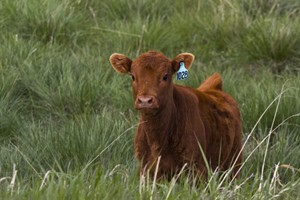
It’s all about providing the best protection for calves against common diseases from the get-go, says Beierbach, who ranches near Whitewood, just west of the Manitoba border.
He administers a three-way intranasal vaccine to pasture-born calves at anywhere from two weeks to two-and-a-half months of age. As the herd is processed after May-June calving, usually in early July, all calves also receive an eight-way injectable clostridial vaccine, including tetanus. And then at fall weaning, they also are vaccinated against IBR and BVD. Beierbach believes in covering the bases.
“From the research I’ve seen, the nasal vaccines do a better job of providing immunity to the calf early on,” says Beierbach. “And from my observations, I believe I am seeing improved health in my calves.”
Beierbach is following research that shows nasal vaccines can do a better job of providing protection to young calves over the critical first few months of life than injectable vaccines. But that statement needs some explanation.
There is nothing wrong with the well-established seven-way, eight-way, or nine-way injectable (intramuscular and subcutaneous) calf vaccines, but believe it or not, on beef operations that follow a sound vaccination program in the cow-herd, that program can actually be somewhat antagonistic toward injectable vaccines used in the calf program. As intranasal vaccines have a different and faster route of entry into the calf’s system, they avoid what’s described as “maternal antibody interference”. The calf’s immune system in the nose (upper respiratory tract) is more rapid than the systemic or boyd’s response, making the uptake of nasal vaccine so effective.
Just as a refresher — viral or bacterial vaccines may be killed or live. Live vaccines contain bacteria or a virus that has been modified (MLV). This means they’ve lost their disease-causing ability. Killed vaccines are just what the name says – they’ve been inactivated with a process that results in their death.
The Vaccine Conflict
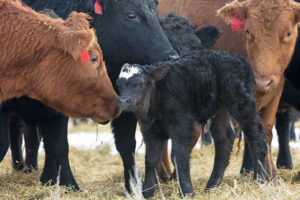
Philip Griebel, a researcher at VIDO (Vaccine and Infectious Disease Organization) at the University of Saskatchewan, explains the conflict that happens as the cow transfers immunity to the calf through its colostrum. The MLV injectable calf vaccines, for example, —delivered through subcutaneous or intramuscular injections — actually deliver modified disease virus presenting just enough of a challenge to help the calf start building its own immunity against the diseases. When antibodies are transferred from the mother to the calf through colostrum, those antibodies recognize these modified live virus as a threat and attack them, ultimately blocking the effect of the injectable calf vaccine.
Griebel is saying it is important to have a comprehensive vaccination program in the cowherd, along with a comprehensive vaccination program in the new calf crop. Even if cows are producing both good quantity and high quality colostrum, the comprehensive vaccination programs are just good insurance toward herd health.
“The key is in circumventing the maternal antibodies present in calves”, says Griebel. These antibodies, present in the animal’s blood, neutralize the intramuscular vaccines and reduce the effectiveness of the booster follow-ups. However, maternal antibodies in the nasal cavity are cleared from calves within three to five days after birth, allowing the intranasal route to work more effectively.
So research is suggesting, the best approach to providing protection to the calf is actually a one-two punch — administer a nasal vaccine at some point during the first few days to the first two or three months of a calf’s life and then follow that up with a broader spectrum injectable vaccine.
The nasal vaccines, although more limited in scope, are quite effective in providing immunity, says Griebel. Among current nasal vaccines on the market, one is a two-way vaccine delivering protection against IBR and PI3 (infectious bovine rhinotrachetis and Paraininfluenza, respectively). Another is a three-way product that covers IBR and PI3 as well as BRSV (respiratory syncitial virus). And there is also a fairly new one that delivers a scours vaccine.
Producers will still need to look to injectable intramuscular or subcutaneous vaccines for protections against BVD and clostridial (Blackleg) disease complex.
Maintaining a high health status in the overall herd should include a proper vaccination program for both cows and calves, says Griebel.
“If you have an absolute gold standard vaccination program in your cow herd — cows are healthy, producing high volumes of good quality colostrum, and you’re certain your calves are up and nursing early and getting the colostrum they need — then you might not need to vaccinate newborn calves,” he says.
It is obviously difficult to measure whether calves are receiving adequate colostrum though, and intranasal vaccination provides increased confidence that the calves will be able to quickly develop their own immunity to supplement the maternal immunity transferred from the dam.
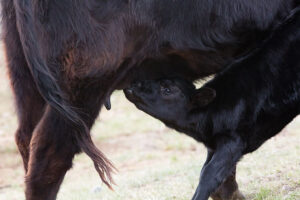
And he also notes while good quality and quantity of colostrum will transfer important antibodies and immunity to calves for a while, the protection also declines with time. “Even in herds with a good cowherd vaccination program, calves may receive good early immunity, but as cows are out on pasture, those maternal antibodies are beginning to wane by the time the calves are three to five months of age. A vaccination program will not only set the calves up during the first few weeks but through their whole life so producers also need to be thinking ahead.”
Protection from Pneumonia
Nathan Erickson, an assistant professor at the Western College of Veterinary Medicine sees the intranasal vaccines having a good fit in a couple key areas.
“If you are having a problem in your herd with young calves developing pneumonia at one to two months of age, for example, then an intranasal vaccine administered at one to three days of age can provide protection during that high risk period,” he says.
Also, the first intranasal vaccines administered at branding or spring turnout, when calves are two to three months of age and the maternal antibodies are still present, can be very effective in helping prevent cases of summer or pasture pneumonia.
Griebel says the timing to administer a nasal vaccine is usually determined by practical circumstances although earlier is probably easier than later. “When to vaccinate is usually determined by when producers have access to cattle,” he says. So there is no set timeline, although somewhere between two to three days of age up to about two to three months of age is probably a good window.”
In practical terms access is probably most common within the first one to two days of a calf being born as it is being tagged, or two or three months of age when the herd is being processed before turn out to summer pasture.
Erickson, says it is probably best to wait a day after a calf is born before using a nasal vaccine to ensure the calf’s nostrils are clear of any fetal fluids. When using live vaccines timing is important — use the product within about an hour after mixing. “Follow the label directions, mix and use as directed and also administer the dose as directed,” he says. “Use the proper dose, to ensure proper efficacy.”
Economics Support Proper Vaccination
While a proper vaccination program takes time, money and increased management, researchers say the economics back the effort.
The 2014 Western Canadian Cow-Calf Survey, for example, found beef producers were experiencing calf death losses after the first 24 hours of about seven per cent. And of those, about 30 per cent were attributed to diseases such as pneumonia and scours. Similarly, Nathan Erickson points to other studies, which showed the calf mortality rate at about four per cent in unvaccinated beef herds with severe disease outbreaks. On beef operations that experienced extremely severe disease outbreaks, with no vaccination, the mortality rate was as high as 13 per cent. Whereas the studies also showed on beef operations with a vaccination program the calf mortality rate was under one per cent.
Erickson says in herds that did vaccinate the cost of vaccination, treatment, production losses and death losses spread over the entire herd worked out to about $17 per head. In beef operations that did not vaccinate, the cost of losses averaged $60 per head. “When you consider the cost of vaccine averages about $3.50 per treatment, it doesn’t take long to recover your costs,” he says. “Even on operations with mild disease outbreaks, saving one or two calves covers the cost of a vaccination program.”
Do it Right: How to Administer Nasal Vaccines
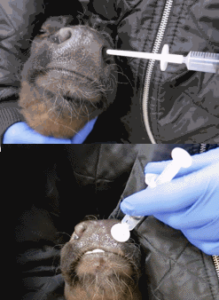
While it is not difficult to administer the nasal vaccines, it does need to be done properly — it may be easier to restrain the calf at three days of age rather than three months of age.
The liquid nasal vaccines can be administered similar to an injectable vaccine. If it is a two cc dose, for example, load that into a syringe or set a multi-dose gun. The needle, however, is replaced with a specially designed two-inch long plastic tube or cannula, with a depth-control ring or tab and inserted into a nostril. The intranasal vaccines are also available in single dose vials.
The vaccine needs to come into contact with the wall of the nostril, which means the calf’s head needs to be restrained and turned up so the liquid runs in instead of out. It only takes a couple seconds to deliver the dose, but the head needs to be in the proper position so the product makes contact. It is not necessary to time the dose with the calf’s inhale – you don’t want the vaccine to end up in the calf’s lungs.
“You can’t just aim at the nostril,” says Griebel. “It has to be properly inserted, and the calf’s head needs to tilted up. If the vaccine ends up on your boot it isn’t doing any good. That’s why we have found it easier to administer in younger calves. Once you get into calves that are feedlot age, six months of age, it can become a challenge. Cattle hate to have anything inserted in their nostrils.”
Beierbach says on his ranch heifers begin calving April 20, cows begin May 10. He processes the whole herd in early July. Calves are heel roped and restrained on the ground as the vaccine is administered in the nose.
While research is still ongoing to determine a more definitive answer on the timing of the two types of vaccines, the general advice to optimize effectiveness at this stage is to administer the intranasal vaccine early on — anywhere from one-day to two, three even four months of age and don’t administer the intramuscular or sub-Q vaccines until the calf is two months of age or older.
Griebel says in what he’s read he is aware of no conflicts about using intranasal vaccines in a program with intramuscular injectable vaccines. He says it is important to remember if a producer uses a two or three-way intranasal vaccine in the spring, for example, they must also use the same intranasal vaccine in the fall or at weaning to serve as booster. The same applies to injectable intramuscular or sub-Q vaccines.
“We are seeing many producers now using both an intranasal vaccine as well as an injectable with young calves in the spring,” says Griebel. “And then they follow up with booster shots in the fall at weaning. But the booster must be the same intranasal vaccine as well as the same intramuscular or sub-Q vaccine. Producers can’t mix and match the products, not because it would be harmful, it just wouldn’t be effective.”
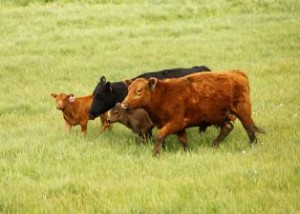
“The intranasal vaccines are designed to provide immunity against a certain set of diseases, and the commonly used eight-way, or nine-way injectable vaccines deal with another set of diseases, so one can’t be used as a booster with the other.”
However, he says it is unclear whether different intranasal vaccine products can be used in combination with other intranasal products to increase the spectrum of disease coverage.
Both researchers make the point — when considering an overall herd vaccination program talk to your heard veterinarian for their advice and recommendations for the appropriate program for your beef herd.
Click here to subscribe to the BCRC Blog and receive email notifications when new content is posted.
The sharing or reprinting of BCRC Blog articles is welcome and encouraged. Please provide acknowledgement to the Beef Cattle Research Council, list the website address, www.BeefResearch.ca, and let us know you chose to share the article by emailing us at info@beefresearch.ca.
We welcome your questions, comments and suggestions. Contact us directly or generate public discussion by posting your thoughts below.